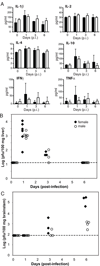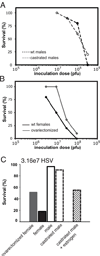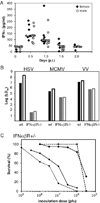Sex differences in murine susceptibility to systemic viral infections
- PMID: 22209097
- PMCID: PMC3313007
- DOI: 10.1016/j.jaut.2011.12.003
Sex differences in murine susceptibility to systemic viral infections
Abstract
Increased susceptibility to autoimmunity in females is often viewed as the consequence of enhanced immunoreactivity providing superior protection against infections. We paradoxically observed greater mortality in female compared to male mice during systemic viral infections with three large double-stranded DNA viruses (herpes simplex virus type I [HSV], murine cytomegalovirus [MCMV], and vaccinia virus [VV]). Indeed, female mice were 27-fold more susceptible to infection with HSV than male mice. Elimination of estrogen by ovariectomy in female mice or addition of estrogen to castrated male mice only partially eliminated the observed sex differences following HSV infection. However, the differences observed in survival between female and male mice were nearly abrogated in the absence of type I interferon receptor signaling and substantially mitigated in absence of DAP12 signaling. Interestingly, the sex-specific impact of type I interferon receptor and DAP12 signaling differentially influenced survival during systemic viral infections with type I interferon receptor signaling enhancing male survival and DAP12 signaling increasing the susceptibility of female mice. These results have potential implications for the sex disparities observed in human autoimmune disorders.
Copyright © 2011 Elsevier Ltd. All rights reserved.
Conflict of interest statement
The authors have no financial conflicts of interest
Figures





Similar articles
-
The virion host shutoff protein of herpes simplex virus 1 blocks the replication-independent activation of NF-κB in dendritic cells in the absence of type I interferon signaling.J Virol. 2011 Dec;85(23):12662-72. doi: 10.1128/JVI.05557-11. Epub 2011 Sep 21. J Virol. 2011. PMID: 21937652 Free PMC article.
-
A sustained type I IFN-neutrophil-IL-18 axis drives pathology during mucosal viral infection.Elife. 2021 May 28;10:e65762. doi: 10.7554/eLife.65762. Elife. 2021. PMID: 34047696 Free PMC article.
-
Herpes Simplex Virus and Interferon Signaling Induce Novel Autophagic Clusters in Sensory Neurons.J Virol. 2016 Apr 14;90(9):4706-4719. doi: 10.1128/JVI.02908-15. Print 2016 May. J Virol. 2016. PMID: 26912623 Free PMC article.
-
Both TRIF and IPS-1 adaptor proteins contribute to the cerebral innate immune response against herpes simplex virus 1 infection.J Virol. 2013 Jul;87(13):7301-8. doi: 10.1128/JVI.00591-13. Epub 2013 Apr 17. J Virol. 2013. PMID: 23596298 Free PMC article.
-
Estrogen and viral infection.Front Immunol. 2025 May 16;16:1556728. doi: 10.3389/fimmu.2025.1556728. eCollection 2025. Front Immunol. 2025. PMID: 40453078 Free PMC article. Review.
Cited by
-
Infectivity and Shedding of Mouse Kidney Parvovirus After Oronasal Inoculation of C57BL/6, CD1, and NSG Mice.Comp Med. 2022 Dec 1;72(6):376-385. doi: 10.30802/AALAS-CM-22-000066. Comp Med. 2022. PMID: 36744512 Free PMC article.
-
Sex Drives Dimorphic Immune Responses to Viral Infections.J Immunol. 2017 Mar 1;198(5):1782-1790. doi: 10.4049/jimmunol.1601166. J Immunol. 2017. PMID: 28223406 Free PMC article. Review.
-
Characterization of Sex Differences in Ocular Herpes Simplex Virus 1 Infection and Herpes Stromal Keratitis Pathogenesis of Wild-Type and Herpesvirus Entry Mediator Knockout Mice.mSphere. 2019 Mar 27;4(2):e00073-19. doi: 10.1128/mSphere.00073-19. mSphere. 2019. PMID: 30918059 Free PMC article.
-
Molecular detection and genomic characterization of Samak Micromys paramyxovirus-1 and -2 in Micromys minutus, Republic of Korea.Virol J. 2024 Oct 15;21(1):255. doi: 10.1186/s12985-024-02532-6. Virol J. 2024. PMID: 39407289 Free PMC article.
-
Sex influences immune responses to viruses, and efficacy of prophylaxis and treatments for viral diseases.Bioessays. 2012 Dec;34(12):1050-9. doi: 10.1002/bies.201200099. Epub 2012 Sep 26. Bioessays. 2012. PMID: 23012250 Free PMC article.
References
-
- Davidson A, Diamond B. Autoimmune diseases. N Engl J Med. 2001;345:340–350. - PubMed
-
- Lleo A, Battezzati PM, Selmi C, Gershwin ME, Podda M. Is autoimmunity a matter of sex? Autoimmun Rev. 2008;7:626–630. - PubMed
-
- Bouman A, Heineman MJ, Faas MM. Sex hormones and the immune response in humans. Hum Reprod Update. 2005;11:411–423. - PubMed
-
- Marriott I, Huet-Hudson YM. Sexual dimorphism in innate immune responses to infectious organisms. Immunol Res. 2006;34:177–192. - PubMed
-
- Zandman-Goddard G, Peeva E, Shoenfeld Y. Gender and autoimmunity. Autoimmun Rev. 2007;6:366–372. - PubMed
Publication types
MeSH terms
Substances
Grants and funding
LinkOut - more resources
Full Text Sources
Medical

